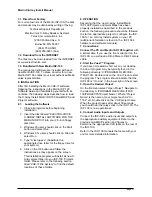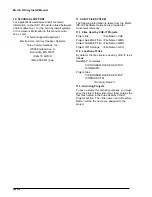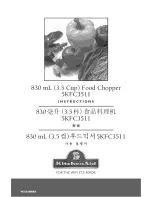
Merlin X-Array Install Manual
page 16
6.4.1. Threshold Determined by Lookup Table
The limiter threshold value may be determined by
the following steps:
a. Set Power Amplifier Gain to Desired Setting:
Set the power amplifier to its highest gain setting
(usually the 0 dBU for full output mode) with its
level control at a high level. The power amplifier
gain control should be set to halfway or higher
so that the amplifier has enough gain (see
comments in previous section). The highest gain
settings may be undesirable due to amplification
of noise and/or hum in the signal chain.
Note the position of the level control and the
amplifier’s input gain mode.
b. Apply Test Signal to Amplifier’s Input:
Apply a sinewave signal of 0.100 V rms (100
mV) at 400 Hz to the amplifier’s input. Any
midband frequency in the range of 250 Hz to 1
kHz is OK as long a your measurement meter is
accurate at the given frequency. For amplifier’s
with balanced inputs, make sure the
measurement is taken across both the “+” and “-”
inputs, and not from either “+” to ground or “-” to
ground. If the measurement is taken at an XLR
connector, this would be across pins 2 or 3 and
not from pin 2 to pin 1 or pin 3 to pin 1.
We suggest using a high-quality battery
operated digital voltmeter (DVM) or equivalent.
This insures that the meter is effectively
balanced and floating with respect to any
grounds. Some inexpensive DVM’s are
notoriously inaccurate at low ac voltages or very
high or low frequencies! Run the meter on its
lowest most-sensitive ac scale, such as the 0- to
1.999-V or better the 0- to 0.1999-V scale, etc.
c. Measure Amplifier’s Output Voltage:
Using the same meter you used in step 1,
measure the power amplifiers output voltage.
The speakers need not be connected or the
amplifier loaded for this measurement (10 V ac
into an X-Array Install system is loud!). Most
modern amplifiers’ output voltage will change
very little with or without load at these levels.
Note this value.
d. Look Up Threshold in Table:
Using the measured amplifier output voltage
determined in step 4, look up the threshold value
in the following table by finding the intersection
of the measured output voltage and the
recommended threshold.
6.4.2. Threshold Calculation Given Amplifier Gain
The limiter threshold may by determined by direct
calculation given the gain of the power amplifier in
dB. The gain may be known by manufacturer’s
rating or by direct measurement using the following
method.
6.4.2.1. Measuring Power Amplifier Gain
After setting the power amplifier gain control to the
desired operating position, its gain must be
measured accurately (see previous comments).
The power amplifier gain may be measured by
energizing the amplifier with sinewave signal (with
frequency in the range of 250 Hz to 1 kHz) and then
measuring the input and output voltages with an AC
voltmeter (see previous meter comments). The gain
is then determined by dividing the measured output
voltage by the measured input voltage and then
converting to dB. We suggest driving the amplifier
with a signal 0.050 to 0.100 V rms (50 to 100 mV
rms).
Example:
Assume that you measure an output voltage of 2.91
V rms when a signal of 0.05 V rms is applied. The
gain is therefore 2.91 divided by 0.05 or 58.2. This
may be converted to dB by the taking the log and
multiplying by 20 (using a scientific hand calculator
or equivalent). A value of 35.3 dB results (20 times
the log of 58.2).
6.4.2.2. Threshold Setting Determined from
Power Amplifier Gain
Using the previously determined amplifier gain
value in dB, the limiters threshold may be calculated
from the factory recommended values given in the
QuickSETS described earlier. The given threshold
values assume a power amplifier gain of 42 dB.
If your power amplifier gain is different from the
assumed gain, a new threshold value must
calculated. If your amplifier gain is greater than the
assumed value, the recommended threshold must
be reduced by the exact amount of dBs that your
amplifier exceeds the assumed gain, and vice
versa.
Example:
The recommended limiting threshold is -25 dB and
your measured amplifier gain is 45 dB. Because the
measured gain is 3 dB higher than the assumed
gain of 42 dB, the threshold must be reduced by 3
dB yielding -28 dB. Conversely, if your measured
gain was only 28 dB, 14 dB lower than assumed 42
dB gain, the threshold must be increased by 14 dB
yielding -11 dB.
7. SOFTWARE AVAILABILITY
The X-Array Install Merlin ISP-100 setup software
and manual is available three different ways: 1.
direct from the factory, 2. by download from the
INTERNET (with manual in PDF format), or 3.
bundled with each new Merlin ISP-100. These
methods are described as follows.



































